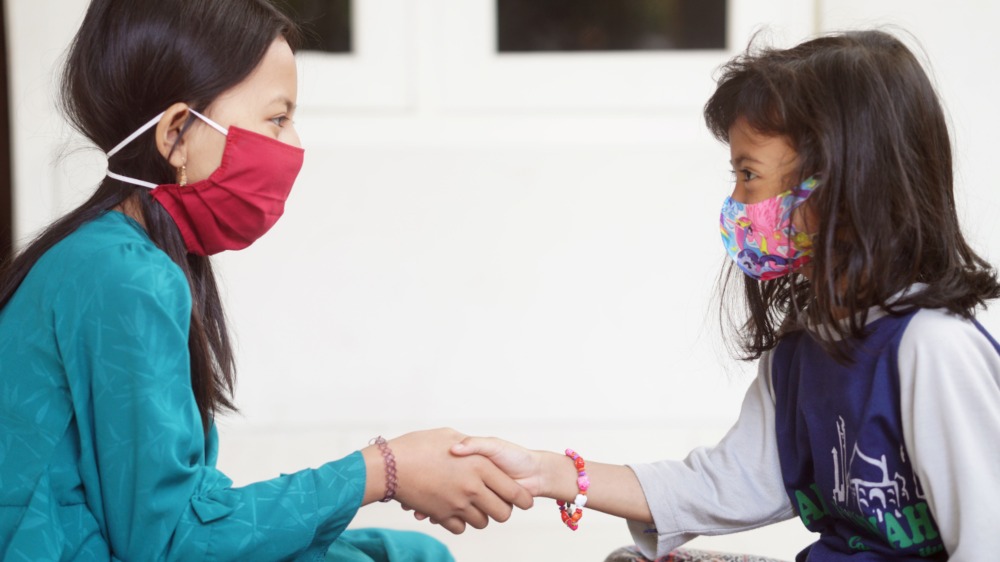07/15/2024
Nonverbal Communication While Wearing Face Coverings
In the age of health vigilance, face coverings have become an integral part of our daily attire, but they pose unique challenges to the ways we non-verbally convey emotions and intentions without saying a word. South Shore Therapies understands the importance of teaching how to adapt to these challenges and foster strong communication skills in children.

The Importance of Nonverbal Communication
Nonverbal communication, often underestimated, plays a pivotal role in how we connect with others. It goes beyond words, fortifying our spoken language and conveying a myriad of emotions. From the subtle twitch of an eyebrow to the warm embrace of a hug, nonverbal cues help us interpret the unspoken messages that lie beneath the surface. It is the silent yet profound dialogue we engage in, allowing us to truly understand and connect with one another on a deeper level.
Types of Nonverbal Communication
Nonverbal cues encompass a wide range of gestures, facial expressions, posture, and eye contact. These subtle cues are incredibly powerful, accounting for an astonishing 55% of all daily communication. However, with face coverings becoming ubiquitous in today's world, our reliance on nonverbal cues has shifted. As a result, we find ourselves depending more heavily on what can be seen outside the mask--primarily, our they ways in which we communicate with our eyes and our body. Our eyes, play a significant role in conveying emotions and intentions. Similarly, our body language has become a crucial tool for expressing ourselves and understanding others. As we navigate this new normal, the importance of mastering and interpreting these visible nonverbal cues cannot be overstated.
Ways to Improve Communication When Wearing Masks
To overcome the social and language barriers that mask wearing can present, we can concentrate on being intentional with the facial and body features that are still visible. One of the most crucial body parts to consider is our eyes. With our eyes being the only main facial feature visible while masking, maintaining eye contact or showing active listening with our eyes is important. It not only helps maintain a connection with others but also demonstrates attentiveness and interest in the conversation.
Additionally, expressive body language can play a vital role in compensating for the lack of visible facial signals. The use of gestures can help convey emotions and intentions, making up for the hidden smiles or other facial expressions that would typically be observed. By utilizing expressive body language, we can make sure that our messages are not lost or misinterpreted, fostering effective communication even behind the mask.
These adjustments not only help us overcome the limitations of wearing masks but also guarantee that our relationships continue to thrive. Despite the physical barrier, we can still maintain strong connections and convey our thoughts and emotions effectively.
Masks and Speech-Language Development in Children
For children, whose language development are highly influenced by visual and auditory input, wearing masks can potentially obscure critical linguistic cues, which may raise concerns among parents and educators regarding communication development. However, by being intentional with our nonverbal cues, such as facial expressions and gestures, and providing additional verbal context, we can effectively bridge this gap and support optimal communication support for our little ones. This proactive approach helps to mitigate any potential impact on their language and social development, prompting a nurturing environment for their growth and learning.
Five Tips for Communicating Around Your Mask
1. Use Gestures More Often: When you complement your words with expressive hand movements, it helps to visually convey your point and engage your audience. Gestures can add emphasis, clarity, and even create a memorable impact.
2. Emphasize Vocal Inflections: Your tone of voice is a powerful tool to convey emotions and enhance your message. By varying your vocal inflections, you can effectively communicate different sentiments. The lilt of your voice can communicate happiness, while a steady tone can convey seriousness and authority.
3. Improve Your Articulation: When communicating without the visibility of your mouth and lips, it becomes even more important to speak slowly and clearly. By enunciating your words carefully, your message is understood and interpreted accurately by the listener.
4. Practice Active Listening: Active listening is an important skill in effective communication. Demonstrate your engagement by nodding, maintaining eye contact, and using vocal affirmations such as "mm-hmm" and "I understand." These cues reassure the speaker that you are actively involved in the conversation.
5. Patience is Key: It's important to remember that adapting to a new way of interaction takes time and patience from both parties involved. Communication is a two-way street and understanding each other's cues and nuances may take time. By exercising patience and empathy, we can improve our communication and relationships.
By integrating such methods into our daily exchanges, we better our chances of understanding each other, even when wearing a mask.
Enlist the Help of South Shore Therapies Today
At South Shore Therapies, we understand that adapting to these changes, especially for children, can be challenging. But with nurturing guidance and the right strategies, we can make it another milestone in effective communication.
Let's continue to support one another as we navigate a post-pandemic world. At every step, South Shore Therapies is here to provide the empathetic, expert assistance required to support clear and effective communication for future generations.
We invite you to reach out for support and more personalized intervention tailored to your child’s individual needs. Visit us online or call us at 781-335-6663 for any inquiries or to set up an intake call. Together, we can cultivate communication and connection for all ages.